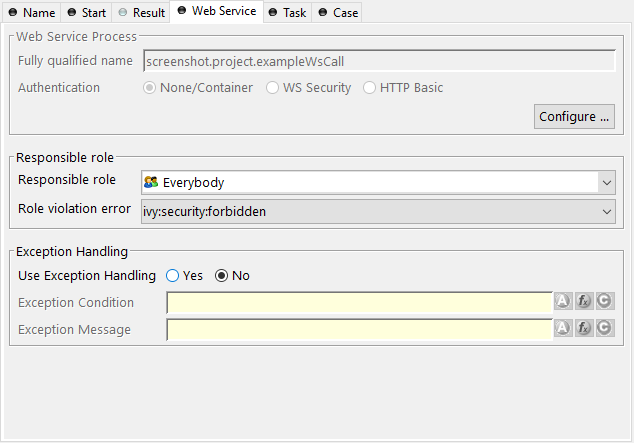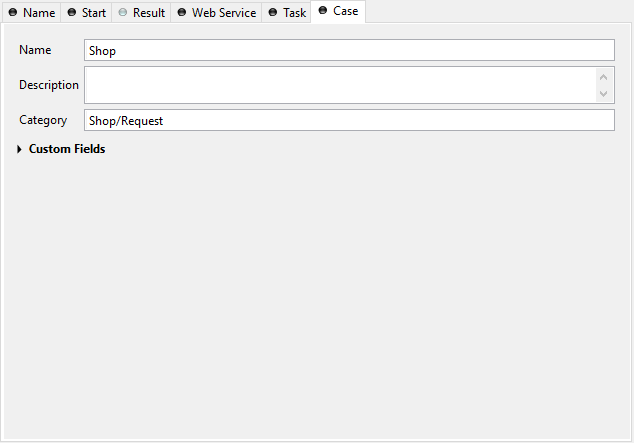Web Service Process Start
 The WS Start element is located in the WS Process drawer of
the process editor palette and only available in web service processes.
The WS Start element is located in the WS Process drawer of
the process editor palette and only available in web service processes.
Element Details
Each Web Service Start element will create a web service operation in the web service where it is located. It has input and output parameters.
Inscription
Name Tab
The Name Tab is included in the mask of all process elements and contains the name and a description of the element.
Start Tab
This tab is used to define the name and input parameters of the web service operation. See Start Tab for a more detailed description.
- Start signature
The name text field allows you to specify the name of the web service operation. This is the name that will also appear in the generated WSDL and will be used to call the web service operation.
- Input parameters
This table is used to define the input parameters of the operation. The list may be left empty if the operation does not require any input parameters. To add a new parameter, click the green plus icon and specify the name and type of the parameter.
Warning
Some restrictions apply to the definition of Web Service process input parameters. Please follow the rules below:
Do not use the interface type
Numberas type for an input parameter. Instead use concrete types likeIntegerorDouble.Do not use complex types that contain a
Listattribute as input parameter (e.g.Employeewith an attributeprojectsof typeList<Project>). Use ajava.util.List(e.g.java.util.List<Project>) as type for such attributes instead.In both cases you can still map the incoming values to process attributes of type
NumberorList<?>in the mapping section.- Mapping of input parameters
The input parameters defined above are available as fields on the
paramvariable. You can assign the parameter values to the internal data fields in the table.Note
The reason why you have to assign the incoming parameters to local data is to keep the implementation independent from the declaration. By doing so the implementation can be changed at a later point of time (rename data, use different data types, etc.) while at the same time the web service interface is kept stable. This has the effect that none of the clients of the web service have to be changed/adapted after an internal data change.
Result Tab
The Result Tab is used to define the return parameters of the operation.
Web Service Tab
This tab is used to change the web service specific settings of the operation.

Web Service Tab
- Web service
The web service section shows the web service’s name and authentication options. Click the Configure… button to open the configuration dialog. See inscription mask of the web service process for details.
Note
Since these settings are defined per web service and not per web service operation, any changes here will have an impact on all the operations within the same process, i.e. web service.
Tip
Use fully qualified class names to generate specific target namespaces in the WSDL of your web service (e.g.
ch.ivyteam.svn.CustomerServiceas demonstrated on the screenshot above will resulttargetNamespace="http://srv.ivyteam.ch/"in your WSDL)- Responsible role
You may specify a role that is required to call this start. If the start is invoked with a user not owning the selected role, an error will occur. The error can be handled by a catching Error Start.
- Exception handling
The exception handling allows your web service operation to throw a custom exception if your process could not complete normally. When such an exception is thrown, no output parameters are returned to the client.
After activating the exception handling, define the condition on which the exception should be thrown and the message to be returned to the caller.
Task Tab
This tab defines information relevant to the task. The task created for a web service call will normally not appear in a task list of a user. The values on this tab are therefore only relevant for analysing the finished tasks and not for the task list itself.

Task Tab
- Entry in Task List
Defines the name and description of the task.
- Priority
Here you select the priority of the task.
- Custom fields
The values set on this table are only informational and have no effect on how this task is treated by Axon.ivy.
- Code
This is a post construct code block for the Task that is defined in this tab. The created Task is provided as variable called Consult Task Tab for details and use cases.
Case Tab
On this tab you can configure the Case created by this Web Service Process Start. See Case Tab.

Case Tab
Customization
The Web Service endpoints are generated automatically in a Java file which contains JAX-WS annotations to define the Web Service. If the default configuration does not fit your needs, the generated Java file can be managed and extended by the developer.
The Java file is located in the folder
[project]/src_wsproc/[fully-qualified-name].java and gets
interpreted by the CXF library (http://cxf.apache.org/). The file has to
be moved to the src-folder of the project and has to be in line with
the configuration of the WS Start Elements of the process. The
fully-qualified-name is defined in the inscription mask of the
process.
The Java file in the src-folder is under control of the Developer.
When a WS Start element configuration changes, the change has to be
adapted manually in the Java file.